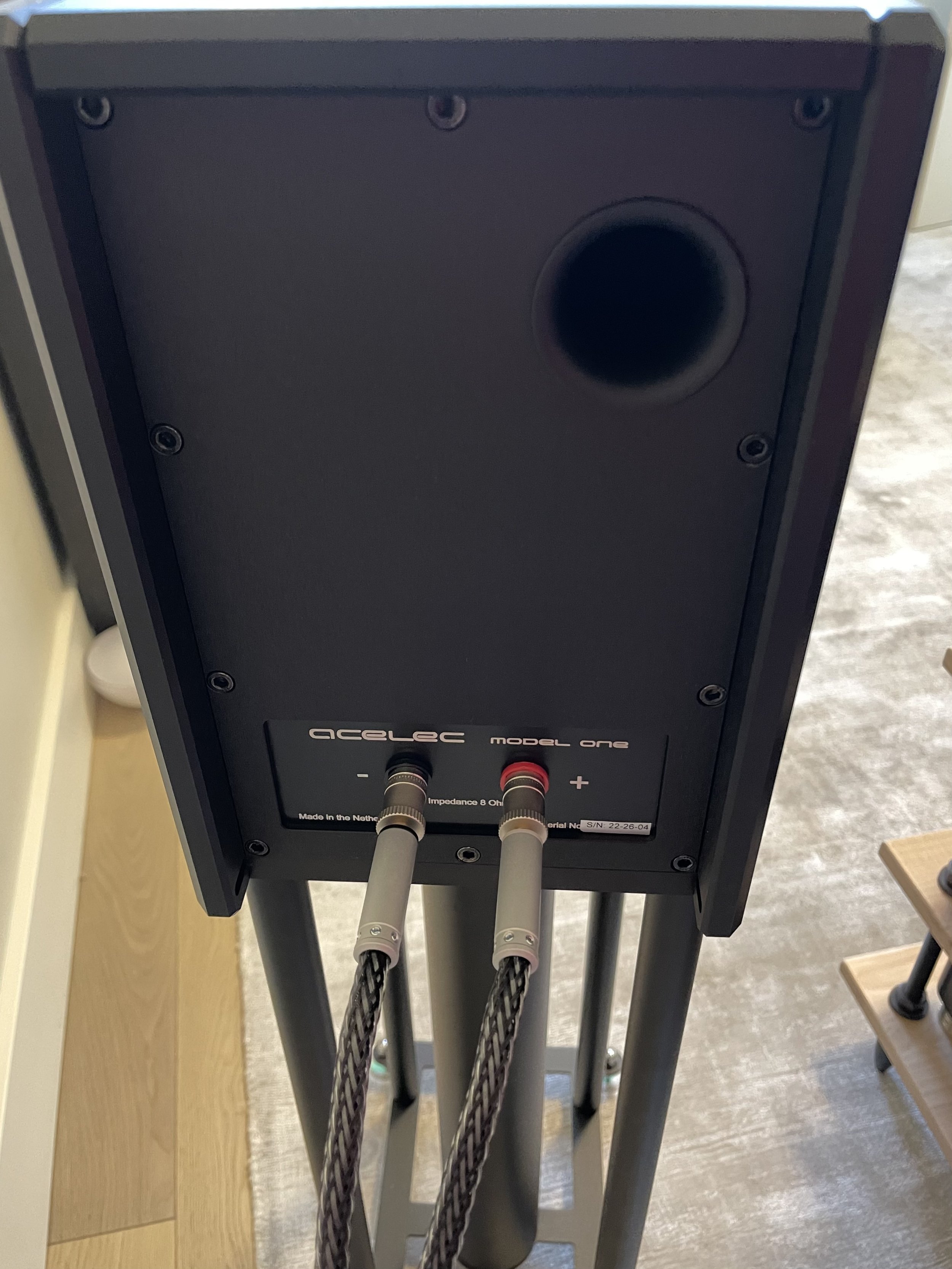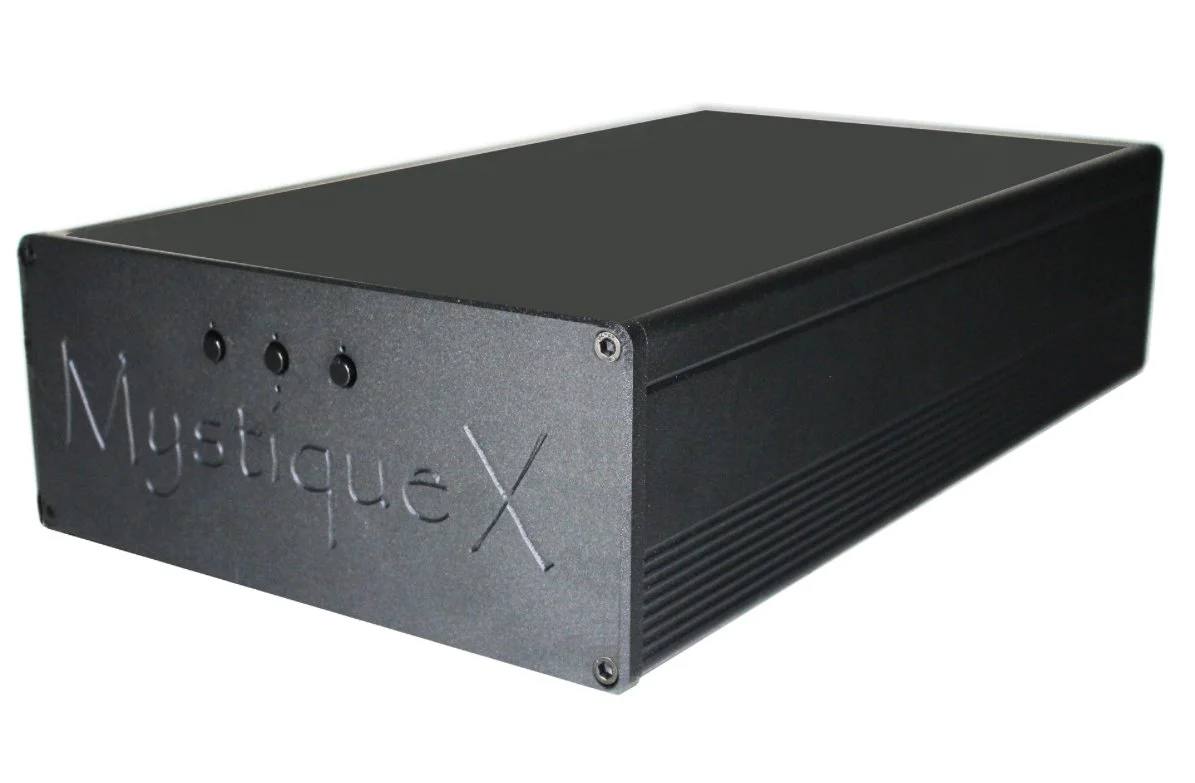Acelec Model One Loudspeaker
Our Karl Sigman wrote and very much enjoyed a Dutch DAC last year, the Sonnet Digital Audio Morpheus. Sonnet also has a subsidiary company, Acelec, maker of the Model One Loudspeaker here under review.
Rob Fritz of Audio Art Cable, the Acelec US distributor, contacted me to set up a review. Before you know it, FedEx had them here two days ahead of schedule! Will wonders ever cease? Thanks to our friend Rob for shipping the good-looking monitor loudspeakers to the island.
Features
The $6495/pair Model One is a 2 way, bass reflex design housed in a 15 mm bituminized aluminum frame with a frequency response of 45 Hz to 35 kHz. Drivers include a ScanSpeak 15cm bass/mid transducer and an 18 mm Mundorf Air Motion Transformer. The sensitivity is 84 dB and they have an impedance of 8 ohms.
My Use
Unboxing and setup is a one-person job. They fit perfectly on my Custom Design UK stands and were playing music shortly thereafter. The speakers come with 4 cones (unused). The review turnaround request was shorter than our usual policy, so I allowed myself 24 hours break in.
The fit ‘n finish of the speakers is very high and on build quality alone they warrant the $6495/pair price (Note: the $6495 is an introductory price).
Ancillaries? Only the best for our Dutch friends. The aforementioned superb Custom Design UK FS 104 Speaker Stands ($500), MBL N51 Integrated Amplifier ($17,600), Aavik Acoustics S-280 Network Music Player (€10,000; review forthcoming), Bergmann Audio Magne Turntable ($13,900), Phasemation PP-2000 MC Phono Cartridge ($7000), Phasemation EA-350 Phono Amplifier ($6700) with all connections Ansuz Acoustics at the C2 or top D2 level. Dutch treat! The sand-filled, spiked metal stands have hard rubber tabs on top to accommodate the bottom of the speaker. The FS 104s look like they were built for the Model Ones.
Specifications
Bass Alignment Low Q alignment Vented port system.
Minimum Impedance 5 ohms at 375 Hz
Maximum SPL 110 dBA (Pair)
Power Handling (RMS) 120 W
Recommended Amplifier Requirements 25 – 100 W
Crossover Frequency 1.8 kHz
Cabinet Dimensions (H x W x D) 285 x 195 x 300 mm
Finish Silver or black finish. Special versions or colors on request
Weight 17 kg
The Model One, like the fabulous Magico A1 bookshelf loudspeakers, construction is hardwood over a thick solid aluminum frame. The Magicos are well above the Model One’s introductory price. Each Acelec speaker has a small port. The paperwork suggests easy placement, even close to walls. The speakers are small but mighty. A solid 17 kg in weight.
I asked Rob Fritz to ask the designers a little about the background of the Model One.
Hello Anthony,
Here is Cees Ruijtenberg’s reply to the questions we were kicking around yesterday:
The starting point was the cabinet. The problem with a cabinet is that it usually forms a unit. Despite the effort put into rigidity. This is similar to a church bell. The unity in the material makes it sound beautiful but is this a feature we do not want in particular. Incidentally, if a crack were to appear in the bell, the resonant character would immediately disappear. Milling a cavity in a block of aluminum would cause the same thing because the walls form a unit with each other and are therefore resonant at least at one frequency. The purpose of the cabinet was to connect rigid walls together but they have poor contact with each other. To achieve this a rubber like glue was used to prevent unity between the parts.
The result is a cabinet that is very lifeless.
The cabinet as created would not have come about without my partner Lion Kwaytaal. In addition to our collaboration at Sonnet, Lion has another company where aluminum is machined. In particular, the shape of the joints must allow the glue to get everywhere without creating extreme contact between the parts of the cabinet.
The tweeter, in particular, is a special version that is different in behaviour from the standard versions available, and with it has improved impulse behaviour. The filter is a so-called dual slope type. To keep the phase behaviour optimal, the filter behaves as a first order around the crossover frequency at 1800 Hz and then further from the crossover area it attenuates again with a second first order. So as a result, this becomes a second order but far removed on both sides of the crossover frequency. You would think that this would put a huge load on the tweeter but because of the efficiency of the tweeter which is almost 10dB louder than the woofer we can reduce the power by attenuating it by 10 dB.
Then we also address the woofer at one point and concerns about where the cone is going to break up and what usually gives a bump in the spectrum around 1 kHz at this particular diameter. A linear-like curve is obtained by removing this peak, together with the tweeter. Finally, the impedance curve is corrected. We see that in many designs the impedance is almost never corrected with the result that for example, a moderate damping factor of the amplifier that is applied (in the case of tubes for instance) gives an increase of the amplitude in the crossover area. In the case of Model One, the transfer will remain constant in the mid-range.
Best Regards,
Rob Fritz
Sound
Acelec’s PR, “Extreme stiffness using bituminized aluminum and internal damping of the cabinet to avoid any ringing effects. As a result, this approach avoids any time smearing, particularly with regard to fast and powerful transients” was spot on. No matter the source. material, the speakers remained inert with only the dynamics and voluminous source heard.
The soundstage the speakers throw is wide and deep—it’s difficult to aurally match the small speaker size with the large soundstage. As with all good monitor speakers, imaging was excellent. So far, the diminutive speaker looked and sounded really good.
There was a slight elevation of treble energy for the first 10 or fifteen hours. It was subtle but disappeared quickly. You’ll be enjoying the sound of these speakers and their accomplishments directly out of the box.
The placement was easy. I toe’d in 10 degrees and left a couple of feet from the walls. The speakers are a dream for small rooms but give enough energy to fill a medium room, too. As for Acelec’s claims “the design had to behave efficiently and at the same time act as a simple load for a wide range of amplifiers—encompassing both delicate tubes, as well as powerful solid-state powerhouses”, be sure to check the efficiency with your low-powered SET amp. 84 dB is not especially efficient. With my 400 Watt MBL, no problems.
The bass will surprise and delight you. It’s beautifully balanced within the musical framework yet only goes down to 45 Hz. It was enough in my small room but if you’re in a larger room, the bass may not be enough for your listening predilections. My bass test tracks sounded fulsome and effective including Holly Cole’s “Train Song” and Thomas Newman’s “Dead Already”. In fact, the latter’s performance surprised the hell out of me. To hear all that clean low energy out of such a small box. Wow.
Even at loud volumes, I heard no chuffing from the rear ports.
I used the Analogue Recordings Reiner/CSO vinyl of Strauss’ Also Sprach Zarathustra to hear how the Model Ones handled massed strings. Right after the famous opening comes a slow section beginning with violas and then adding string choirs as it grows to a massive climax. It’s magnificent, and if the tech is there both front and back of house, a speaker can handle the sonorities and wide dynamics. The Chicago strings keep piling on the whipped cream ‘till the sound and volume of high strings are almost exhausted. It’s tough on the gear. The Model Ones fared very well. No matter the repertoire, you’ll max out your ears before the soundstage caves.
I did not have a comparative set of speakers on hand and playing them next to my 50K BØRRESEN Acoustics 01 Silver Supreme Edition Loudspeakers is just not a fair fight. The differences are significant as they should be for that price difference. But I’d put the Model Ones up against anything south of 10K and I’d bet they’d hold their own on any audiophile checklist. Small footprint, easy to place, they look great and have a superb build. Plus they sound great. Once in your system, I’m guessing your upgrade fever will disappear for some time.
Summary
Designer Cees Ruijtenberg’s words to represent his speakers, “Model One is possibly the most transparent conventional loudspeaker available today.” reminds me of Robert Duvall’s outlaw character to John Wayne at the final gunfight in True Grit, “I call that bold talk for a one-eyed fat man!”. That said, the bold talk has a lot of merits. There’s some real magic going on here. Careful design, choice parts and everything well implemented. With the result, you may hear what Ruijtenberg does. The Model Ones certainly are transparent and dynamic bookshelf speakers that can live in many musical settings. And at the introductory price, a steal. Have a listen before the price goes up. Very highly recommended.
Further information: Acelec







